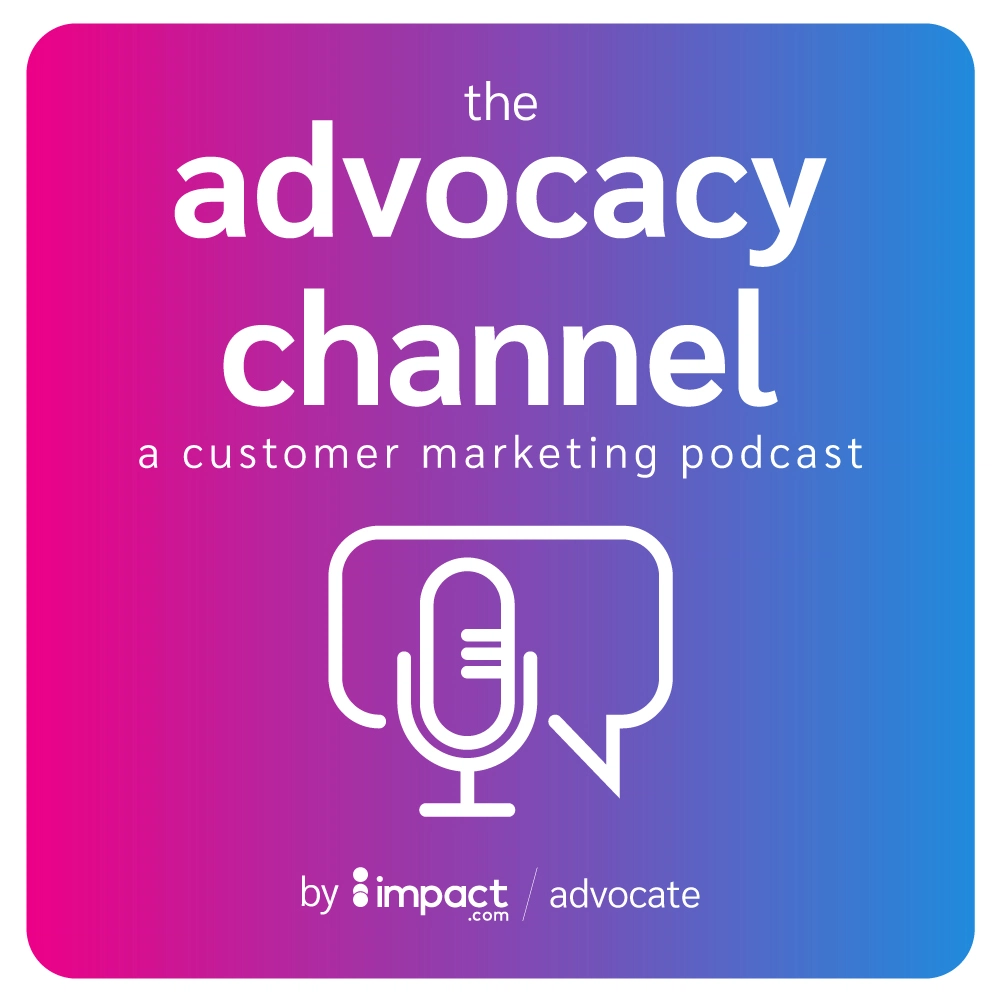When a friend recommends a product or service, you listen—that’s the power behind every successful referral marketing strategy. Maybe you started watching Ted Lasso because colleagues wouldn’t stop talking about it, or downloaded Duolingo because a friend insisted it was life-changing. This isn’t coincidence—it’s the referral effect in action.
Market leaders like Tesla and Airbnb have built empires largely through strategic word-of-mouth. Why? Wharton School research found that referred customers deliver 16-25 percent higher lifetime value than those acquired through traditional channels. They convert faster, spend more, and demonstrate significantly stronger loyalty.
A study by impact.com revealed an even more striking statistic: 86 percent of consumers consider personal recommendations crucial in their purchasing decisions, compared to a mere 2 percent who find traditional advertisements important.
In this guide, we’ll go beyond the “why” to unpack six proven strategies for building a referral marketing program that attracts loyal customers, scales efficiently, and strengthens brand advocacy. Learn how to turn your happiest customers into your most powerful—and cost-effective—growth channel.
The importance of referral marketing
Word-of-mouth marketing rewards customers for bringing in new business. Customers receive incentives, including discounts, cash, or other rewards.
A successful referral program includes key elements that drive effective referral marketing campaigns:
- Win-win rewards: The best programs benefit both referrers and new customers.
- Easy sharing: Referral links should be personalized and easy to share.
- Smart promotion: Integrate referrals into email, social media, and brand websites.
Why referral marketing is beating paid search and social media ads
Paid ads can drive immediate traffic, but they’re expensive and often deliver diminishing returns.
On the other hand, referral marketing has a lower customer acquisition cost (CAC) and generates higher-quality leads. A reported 86 percent of consumers rely on reviews and referrals when purchasing, while only 2 percent consider traditional ads.
Referral marketing is a no-brainer since it taps into the credibility of existing customers to bring in new business. Personalized referral links create a sense of ownership, increasing customers’ likelihood of sharing them.
This doesn’t mean brands should ditch paid media. Instead, combining these channels maximizes reach and effectiveness:
- Amplify referrals with paid ads: Promote referral incentives to attract new customers.
- Retarget referral leads with ads: Keep referred customers engaged and guide them toward conversion.
- Collaborate with influencers and affiliates: Expand referral reach beyond existing customers.
The key benefits of referral marketing: increased revenue and customer loyalty
When done right, referral marketing creates a self-sustaining cycle where happy customers bring in new ones who become loyal advocates. Let’s look at some key advantages.
1. Increases ROI
Referral marketing helps brands win more valuable customers at a lower acquisition cost. According to Will Fraser, referrals are a significant revenue stream.
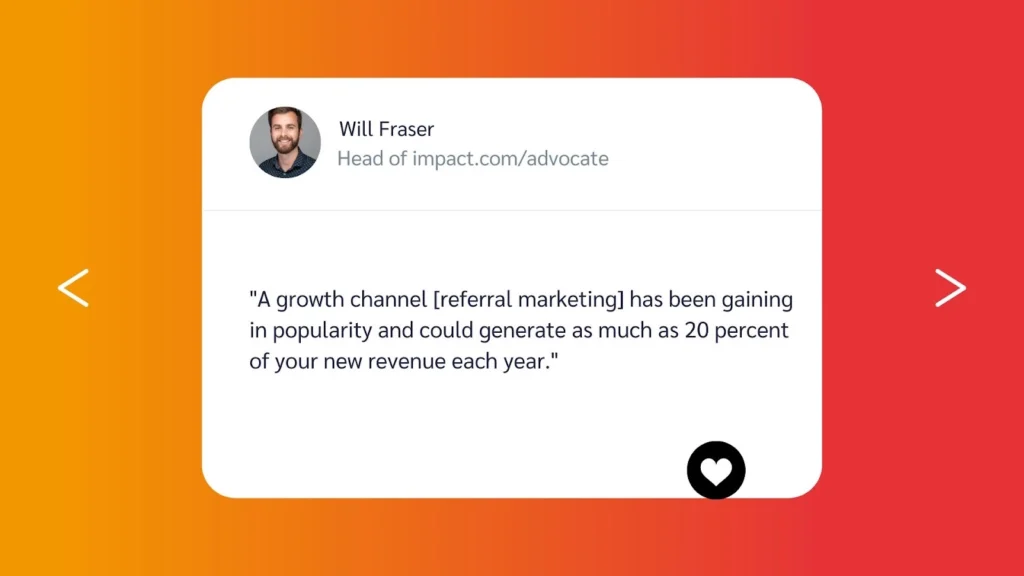
RealtyNinja, a real estate website provider, saw an opportunity to grow through word-of-mouth. The brand achieved impressive ROI on their automated program with impact.com/advocate:

Source: RealtyNinja saw a 2x increase in conversion rate from referrals [case study]
2. Boosts brand awareness and customer loyalty
Research shows that 39 percent of consumers report increased loyalty after referring. People who recommend your brand reinforce their loyalty and encourage others to purchase.
Plus, word-of-mouth creates a ripple effect. Customers who come in through referrals are more likely to refer others.
Keith Posehn, CEO of Zorz, highlights how small perks can drive loyalty:

Offering rewards that customers care about makes them feel valued and strengthens brand connection. The result is more referrals, higher brand visibility, and a continuous growth cycle.
3. Increased credibility and trust with customers
Unlike traditional advertising, which pushes messages to the masses, referral marketing works on personalization. It builds genuine relationships and trust—when people recommend a brand, they put their credibility behind it. Research shows that 88 percent of consumers worldwide trust recommendations from their communities.
Posehn speaks about how brands can strengthen trust through perceived value:
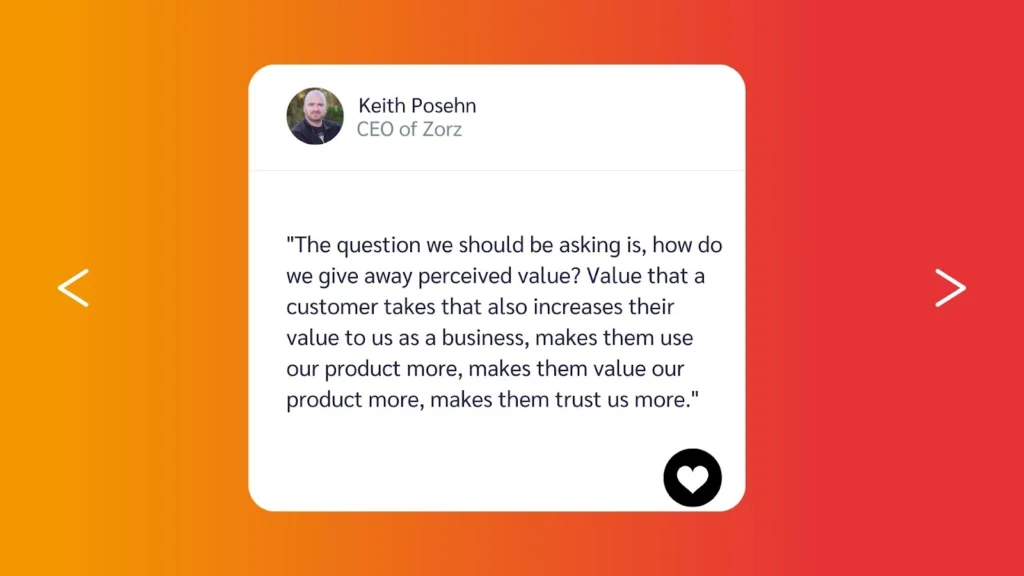
Referral programs tap into this principle by offering meaningful incentives including discounts, upgrades, or exclusive perks reinforcing customer confidence. The more valuable customers perceive a brand, the more likely they recommend it, creating a cycle of trust and credibility.
4. Cost-effective way to engage customers
Unlike traditional paid ads, where businesses pay upfront regardless of results, customer advocacy channels ensure that you only pay for successful referrals. As a result, brands often lower costs and achieve a higher return on investment.
That means predictable costs tied directly to actual sales or sign-ups.
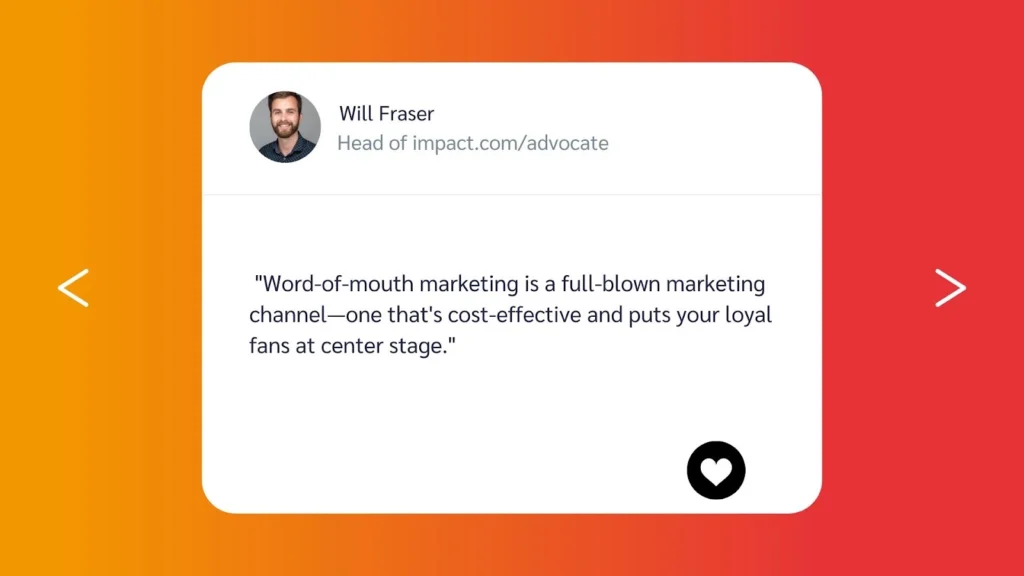
5. Increased customer acquisition
Referral-driven leads tend to be higher quality than those acquired through traditional advertising. They come pre-validated by someone in their network, making them more likely to engage with the brand. For example, RealtyNinja saw 2x higher referral conversion rates than their paid search ads.
Referral marketing also drives better customer lifetime value. Home service business management platform Jobber found that referred customers had an 18 percent higher average selling price than non-referred customers.
Rachel Gershon explains the value that referred customers bring to brands:

Referral marketing attracts engaged, high-intent customers who are more likely to stick around and contribute to long-term revenue.
6. Better customer retention
Retaining existing customers is more valuable and cost-effective than acquiring new ones. Referral marketing helps retain existing customers by keeping them engaged and rewarded over time.
Shannon Howard explains why tracking referral data is key to retention:

One way to measure the impact of retention is through customer lifetime value (CLV), calculated as:
CLV = (Average Customer Lifetime * Monthly Plan Cost) + Average Up-Sell
By tracking how referrals impact customer behavior, brands can fine-tune their programs to keep existing customers engaged. Offering VIP perks, milestone rewards, or incentives for follow-up purchases strengthens customer relationships, leading to higher retention and long-term value.
6 tips to build a referral program that drives growth and loyalty
A strong referral program creates a cycle of trust, loyalty, and sustainable growth.
Use these six proven strategies to build a referral program that keeps customers engaged and drives long-term success.
1. Start your program as soon as its economically viable
Launching a referral program right away is tempting, but timing matters.
As Doug Lewis notes, it’s essential to first have a viable product.

For small businesses just starting out, it’s important to set realistic expectations:
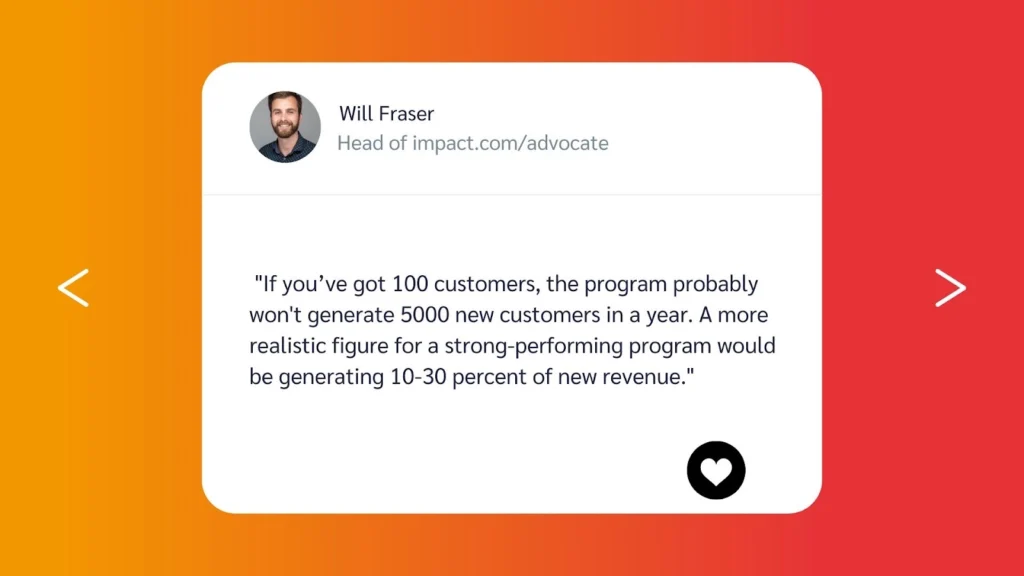
According to the impact.com/advocate team, brands typically find their product-market fit when they hit the mid-millions in revenue. This milestone is a strong indicator of when to scale a referral program. That said, starting small can be an effective approach.
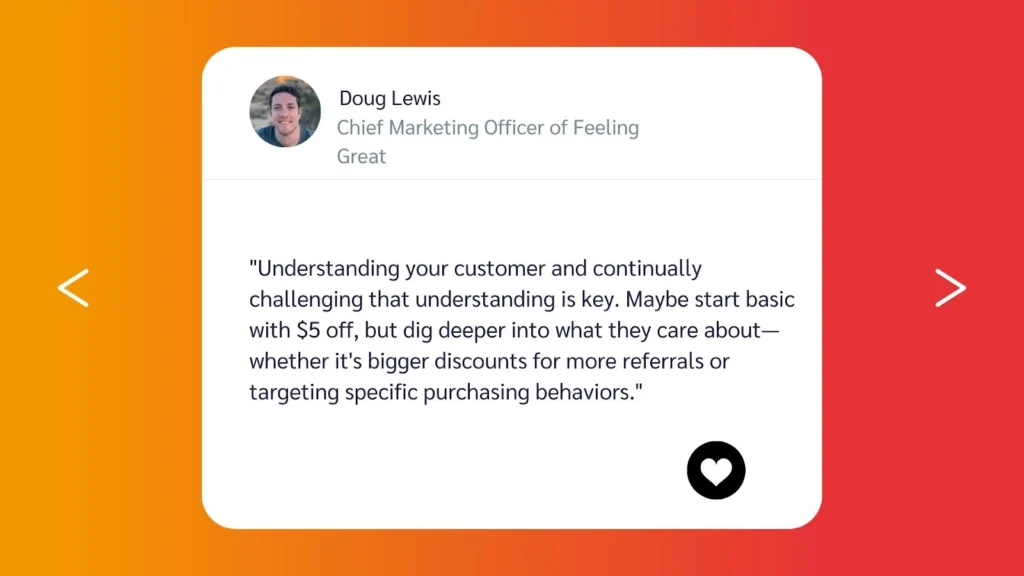
By keeping the program manageable at first, businesses can fine-tune their incentives and scale up when the time is right.
2. Tap into customer loyalty with rewards and special incentives they care about
Rewards aren’t one-size-fits-all. To maximize engagement, brands should tailor their referral incentives to customers’ behaviors, preferences, and where they are in their buying journey. Businesses can strategically decide how to reward customers at different stages using the AARRR (Acquisition, Activation, Retention, Revenue, Referral) model.
Lewis shares his philosophy on choosing the right incentives:

On the other hand, a different approach worked better at Hired, a tech labor marketplace.
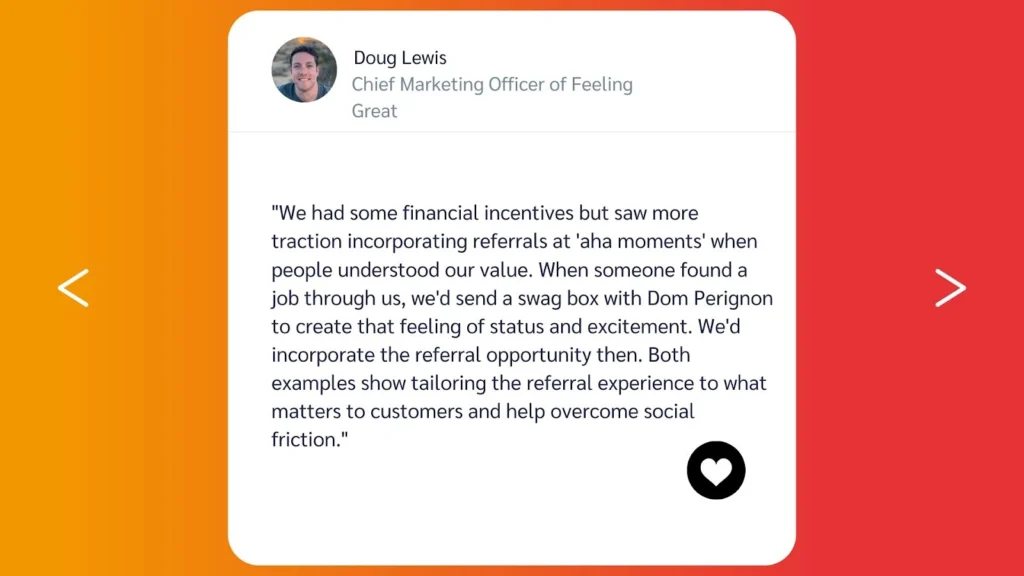
Beyond customizing rewards, brands need to stay top-of-mind for customers. Leslie Barrett notes how consistent engagement builds trust and increases the likelihood of advocacy:
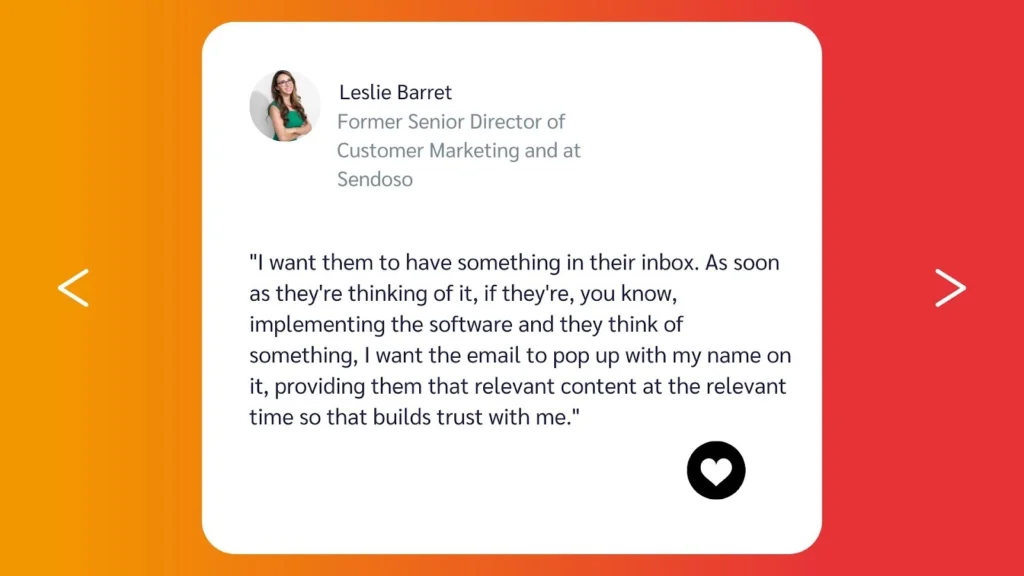
3. Use the low-cost nature of referral to stretch your marketing budget
Since you only pay for successful referrals, you avoid wasting money on ads that may or may not convert.
One way to increase efficiency further is to implement a double-sided referral program, which rewards both the referrer and the referred customer. This win-win situation motivates everyone involved and leads to higher participation rates.
Over 78 percent of referral programs are double-sided, demonstrating their popularity and effectiveness in driving engagement and conversions. Customers who see they’re also benefiting are more likely to actively share referral opportunities.
4. Demonstrate to stakeholders how referral marketing influences revenue
Securing stakeholder buy-in is crucial to successfully implementing referral marketing. Different stakeholders—whether executives, finance teams, or marketing leaders—have unique priorities, and tailoring your pitch to their concerns can make all the difference.
Fraser notes that to gain executive support, you should focus on how referral programs drive customer lifetime value (CLV) and lower acquisition costs. He further explains that finance teams will be interested in how the channel ties expenses to actual results rather than speculative ad spend. Finally, marketing teams will benefit from understanding how referrals generate higher-intent leads than paid ads.
5. Gather feedback and build communities to increase consumer trust
Customer feedback is invaluable for refining and scaling a referral program. Understanding what works and what doesn’t improves incentives, optimizes user experience, and drives higher engagement.
Ozkan Demir delves into the importance of keeping the feedback loop open.
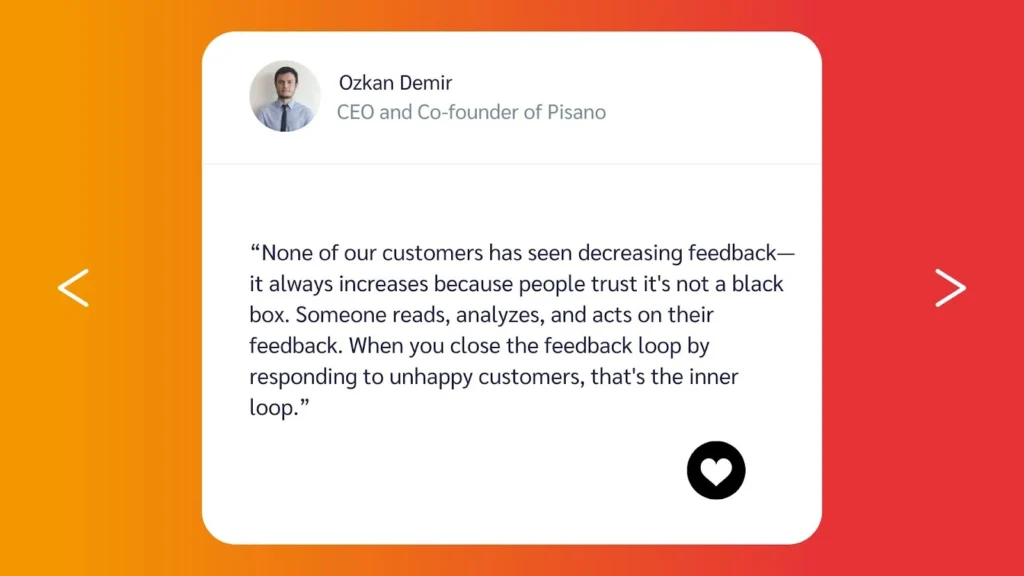
Demir also notes that the key to receiving regular feedback is showing customers that you value their opinions.

Brands can collect feedback through various channels, including:
- Surveys: Ask customers what incentives motivate them most.
- Behavioral data: Track referral activity to understand what drives engagement.
- Customer support interactions: Gather insights from questions or concerns related to the referral program.
- Track performance: Monitor referral links to identify which channels and messaging drive the most successful referrals
Barret highlights how creating a community encourages customers to get involved and share their views.
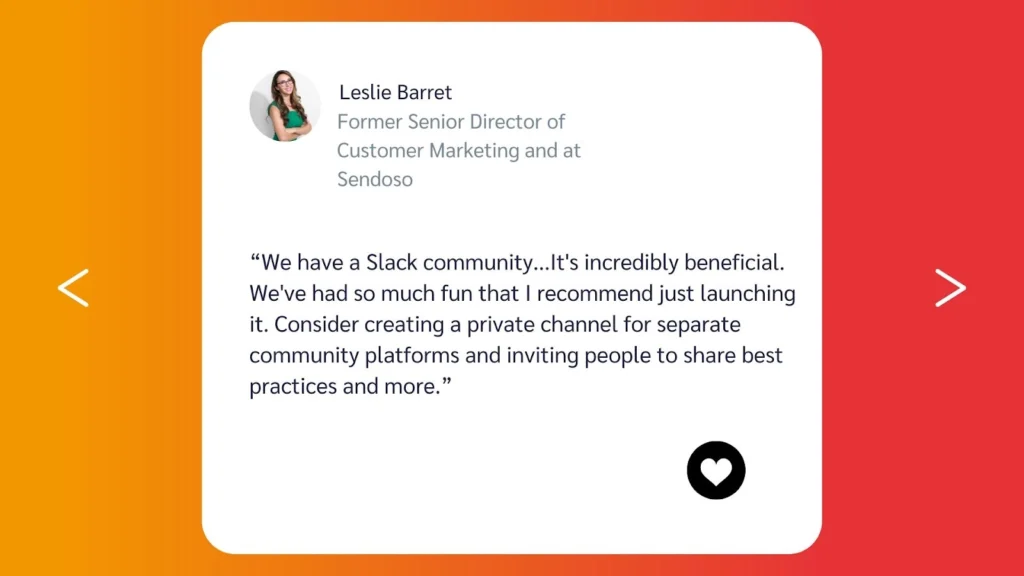
6. Strategically promote your referral program without annoying customers
Referral programs should be easy to find but not intrusive. Customers shouldn’t hunt for referral opportunities or feel bombarded. The key is strategic placement and using natural touchpoints where customers are most engaged.
Lewis shares how his team approached this:
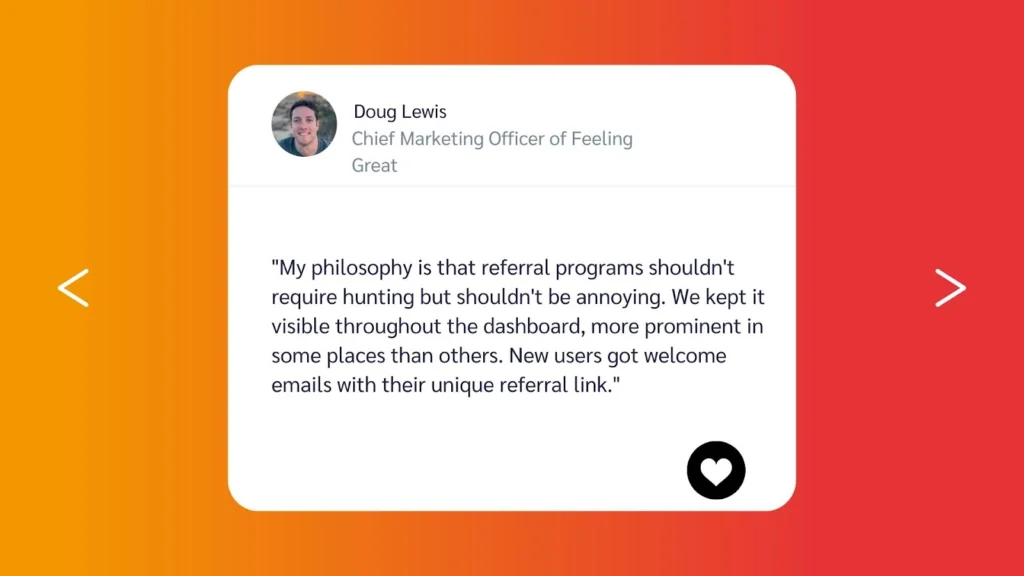
Understanding the audience played a critical role in the success of their referral marketing campaign, with personalized referral links sent via welcome emails generating the highest engagement.
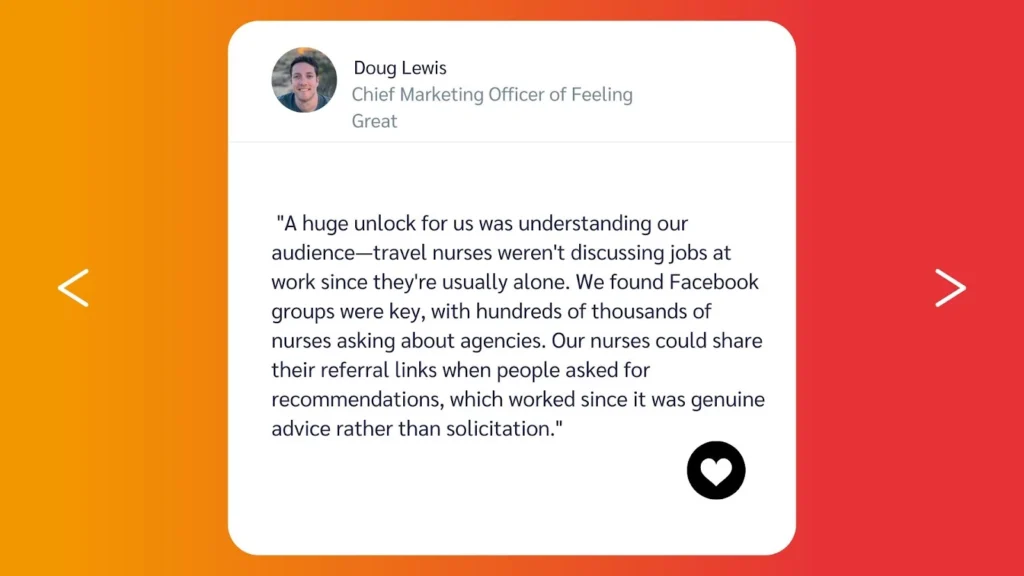
Another important element is removing friction from the process. The easier it is for customers to refer their friends and track rewards, the more likely they are to engage.
Fraser emphasizes this point:

Turn your happy customers into your best growth channel
Referral marketing is one of the most cost-effective ways to bring in new customers and grow your brand. It lowers acquisition costs, builds trust, and turns satisfied customers into advocates who actively promote your business.
If you’re not using referral marketing, now’s the time to start. Keep it simple, customer-focused, and easy to share.
Whether offering discounts, exclusive perks, or cash incentives, make referrals a natural and rewarding experience. By implementing a successful referral program with personalized referral links, you can transform satisfied customers into brand advocates who drive continuous growth through authentic referral marketing campaigns.
Ready to turn happy customers into your best growth channel? Request a demo today.
Want to learn more about how customer referral and loyalty strategies can grow your business? Check out these resources:
- How to win back lost customers: 7 marketing tactics that rebuild customer loyalty [blog]
- 5 successful ecommerce referral programs and why they work [blog]
- How to switch to a new referral platform in 6 easy steps [blog]
- Top 6 customer referral marketing trends your brand can leverage in 2024 [blog]
- 7 referral marketing strategies to grow your retail business [+stand-out brand examples] [blog]
- Turn delighted customers into revenue-driving advocates [ebook]
- More than a pop-up: Building a customer referral program that scales [+ the tech that drives it [blog]
Refferal Program FAQs
Referral marketing grows through trust, not ads. It turns loyal customers into advocates using referral codes and rewards, making it a cost-effective way to build brand loyalty and social proof.
Customer referral programs expand your customer base with referred friends who convert faster and stay longer. They lower acquisition costs while improving customer experience and engagement.
Advantages: Low-cost, performance-based, and great for brand growth.
Disadvantages: Needs engaged customers, balanced rewards, and reliable referral software to manage fraud or tracking.
Define goals, use trusted referral program software like Referral Rock or Viral Loops, and offer double-sided referral rewards. Promote through email marketing, landing pages, and social media sharing buttons.
Customer and employee referral programs drive quick wins, while affiliate and influencer marketing scale growth. Use referral software to automate emails, track referral codes, and manage cash or store credit rewards.
A referral marketing program strategy outlines how to encourage, track, and reward referrals using structured systems, clear incentives, and automation tools that align with your overall marketing plan.
Start with your customer journey map, select referral software to automate tracking, and design incentives that motivate referrals. Test landing pages and email campaigns to maximize conversion rates.
Clear goals, engaging referral rewards, user-friendly referral systems, fraud protection, and analytics tools are essential. Combine customer feedback and tracking referral links to refine performance.
Offer practical value like cash rewards, store credit, or points-based systems. Make sharing easy with social media buttons or automated emails, and use multi-step rewards to encourage ongoing advocacy.
Track referral conversion rate, viral coefficient, participant conversion rate, and customer lifetime value. Use analytics tools to monitor fraud, ROI, and engagement from referred friends.
Use referral marketing software with fraud detection, limit reward frequency, and verify referral codes or customer reviews before approving rewards. Transparent rules protect your brand and reward genuine referrals.
B2B referral programs thrive on customer relationships. Offer tiered referral bonuses or credits, integrate with CRM tools, and align incentives with customer service teams for smoother referrals.


